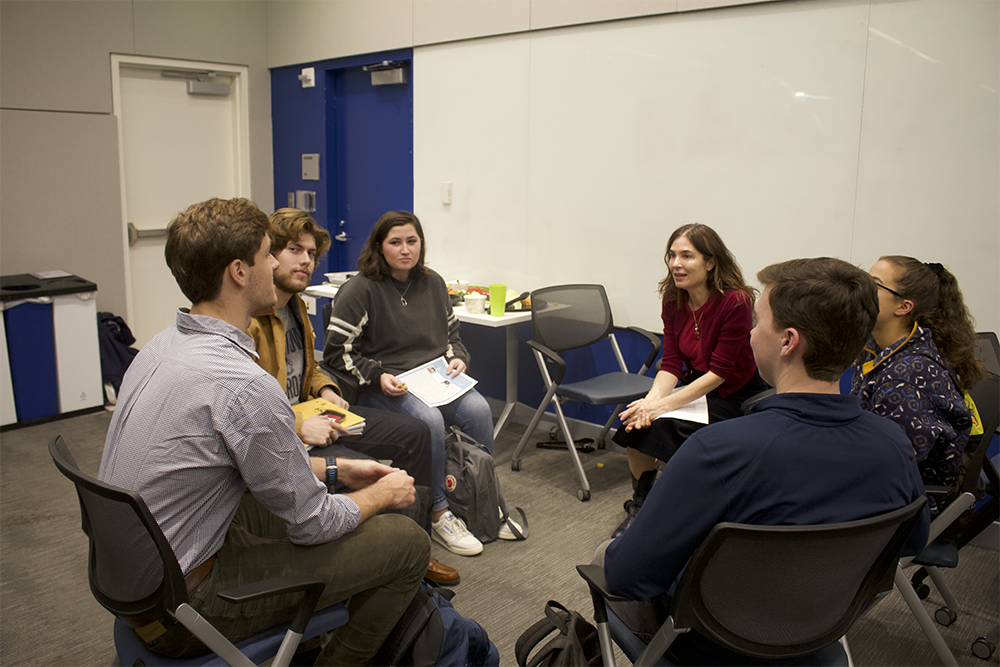Increasing education on nutrition and budgeting for low-income students is a tangible way to combat on-campus food insecurity, panelists said at an on-campus discussion Oct. 23.
The event, titled “Food for Thought,” featured a panel of Georgetown University faculty, students and other activists in the Pedro Arrupe, S.J. Hall Multipurpose Room. Panelists agreed that university students would benefit from education on nutrition and budgeting when starting at Georgetown.
University administrators should integrate an informative program about the realities of food insecurity on campus into new student orientation, according to panelist and Hoya Hub student assistant Liz Fieschko (SFS ’20).

“On a student schedule and on a student mindset, when I was also handling classes and working 15 hours a week, it was more difficult for me to plan that plate and find a good way for me to access it,” Fieschko said. “It’s really, really important, almost in a way, if there was somehow, sometime during orientation — or some sort of week before — all first-years in the school, that we talk about realistically what that looks like.”
The panel also featured Adanna Johnson, Georgetown’s associate vice president for student equity and inclusion; William Hockaday (COL ’20), a food insecurity advocate; Janis Jibrin, a Georgetown adjunct faculty nutrition instructor in the School of Nursing and Health Studies and Erin McGeoy, the CEO of Last Call, a food technology business that communicates deals on surplus food from local eateries.
The event was co-sponsored by GU Students Advancing Food Equity, a student group seeking to alleviate food insecurity on campus, and the Center for Social Justice Research, Teaching and Service. Julianne Licamele (COL ’21), president of Hoya Hub, a food pantry which offers Georgetown community members free, nonperishable food options, moderated the panel.
McGeoy recalled her struggles with food insecurity as a student at George Washington University and called for more transparency from universities to their low-income students around the expenses related to meals while in college.
“When I sat down at my living room table with my family and we were budgeting which universities we could afford, GW seemed okay, but it wasn’t the true price tag that was revealed,” McGeoy said. “Universities are businesses, too.”
In response to food insecurity within the Georgetown community, students launched the Hoya Hub last year, located in the Leavey Center. The panel comes after the pantry doubled in size over the summer. The Meal Swipe Drive, a Hoya Hub-hosted event in which students could donate meal swipes students students facing food insecurity, also doubled in contributions this fall.
Despite growing on-campus resources for students facing food insecurity, Georgetown could still better combat the issue on campus, according to Johnson.
“This feels like a band-aid on a bullet wound,” Johnson said. “If we’re not thinking about the larger structures that create the need for a food pantry, we’re missing the point.”
In 2016, the Georgetown University Student Association conducted a survey that found 54% of the 351 students surveyed — two-thirds of whom received need-based financial aid — experience food insecurity at Georgetown because of the cost of food.
Students especially struggle with food insecurity during breaks or other times when on-campus dining options are closed, Fieschko said at the panel.
“I know from my experience of staying on campus during breaks that when everything would shut down, I would have to figure out where to go to get food as a first-generation low-income student,” Fieschko said.
Johnson and the Office of Student Equity and Inclusion are focusing on the needs of the most marginalized students on campus, particularly on the issue of food security, she said.
“I believe that when we center those students’ needs, that everyone benefits,” Johnson said.
57% of black students and 56% of Latinx students at American universities report food insecurity compared to 40% of white and 45% of Asian students, according to a 2016 College and University Food Bank Alliance-sponsored study.
Food insecurity is an intersectional issue worsened for certain students because of multiple other parts of their identity, according to Johnson.
“I see very much the intersection between race, class, gender, and how issues of food insecurity, the presence of food deserts in various communities, is compounded by issues of race and gender,” Johnson said. “I thought that in coming to Georgetown, this would not be as significant of an issue as it is.”




















